On July 14, India is set to revisit the moon after four years. India will try to do what only three nations have accomplished, and what it tried and failed to do in 2019: soft-land a lander on the moon. Everything that comes after — lander experiments and rover deployment — hinges on whether lander Vikram touches down safely on the moon. Here’s a look at the lander, the mission’s timeline and the challenges the moon will throw at Vikram as it begins the landing.
The lander, rover and propulsion modules
The Chandrayaan-3 mission spacecraft will have three modules — orbiter, lander, and rover. The propulsion module is the one that will take the lander and the rover to the moon. This module does not land on the moon and instead settles on a parking orbit of 100 km x 100 km around the moon. The lander and rover, on the other hand, will separate from the propulsion module to land on the moon.
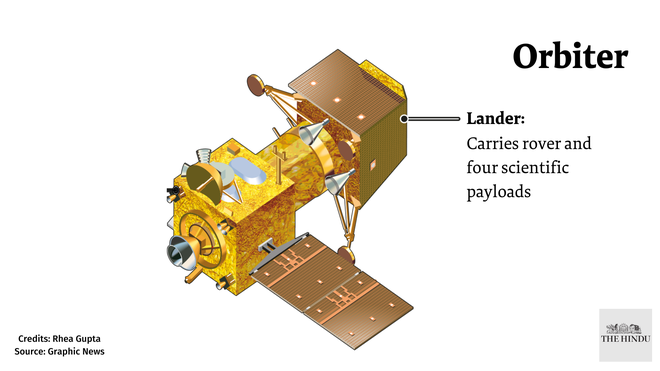
The lander module contains the rover. After the touchdown, the lander will remain stationary at the landing site, while the rover will explore the moon.
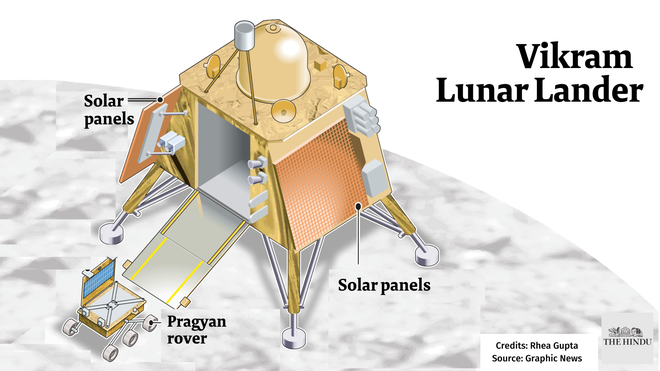
The lander is equipped with advanced technology to ensure proper soft landing. This includes altimeters to measure altitude, velocimeters to measure velocity, and cameras for hazard detection and avoidance. A new laser sensor — Laser Doppler Velocity Meter — has been added to better judge the lunar terrain before landing.
Chandrayaan-3’s path
Chandryaan-3’s path will be similar to that of Chandrayaan-2. It will consist of three stages — Earth orbit manoeuvres, Trans-lunar injection, and Lunar orbit manoeuvres. After these stages have been completed, the lander separates from the propulsion module, enters an orbit closer to the moon and begins soft-landing.
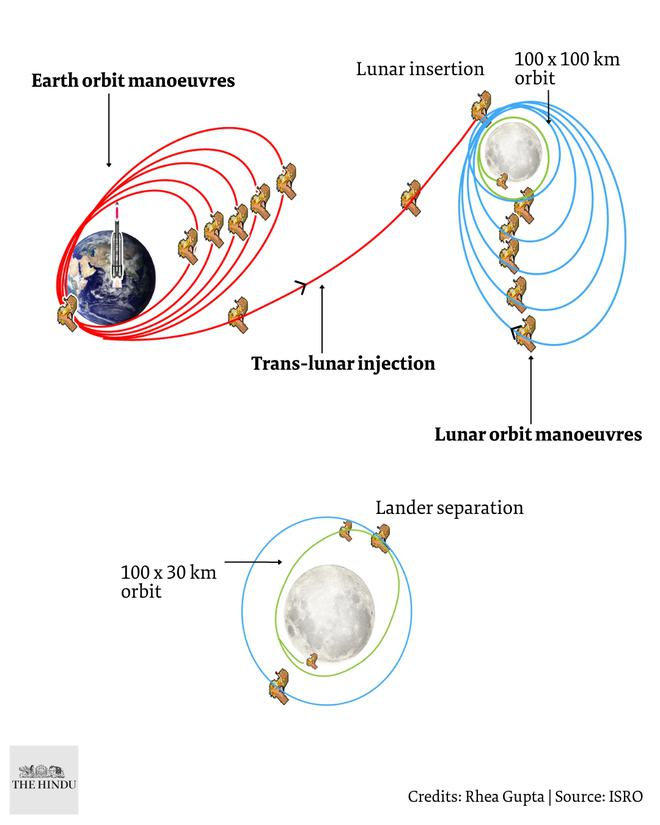
Chandrayaan-3 will make five orbit manoeuvres around the Earth, each time increasing the distance it swings away from the Earth. Then, after it completes the fifth manoeuvre, it begins to move towards the moon. This phase is the Trans Lunar Injection phase.
Similar to the orbit manoeuvres around the Earth, the module orbits the moon four times, each time coming closer. Eventually, it will reach a circular orbit of 100 km x 100 km. Here, the lander separates from the propulsion module, and alters its orbit so it comes as close as 30 km to the moon. Then, the lander commences soft-landing procedures.
To ensure the module is in the right place at the right place, accurate calculations are made to ensure that the launch timing corresponds to the timing of the moon’s orbit around the Earth.
Also read | Chandrayaan 3 will aim for the Moon but look beyond it
Soft-landing challenges
While bridging the distance from the Earth to the moon itself is a challenge, the difficulties do not end there. The ISRO Chief called the 15 minute-duration of the soft-landing “15 minutes of terror” when the lander has to fire its engines at the right times and right altitudes, use just the right amount of fuel, make accurate scans of the lunar surface’s hills and craters and finally touch down. The whole process is autonomous, meaning the ISRO cannot do much to guide the lander from Earth.
A soft-landing goes like this. After the lander separates from the propulsion module and enters a 100 km x 30 km orbit. This means, the farthest it will be from the moon is 100 km, and the closest is 30 km. At around 30 km altitude, the lander begins to use its thrusters to navigate down to the surface. This is the powered braking phase.

As the thrusters work to keep the lander from crashing, the lander reorients itself to 90 degrees for safe landing. At around 100 m altitude, the lander would scan the surface for obstacles. If there are no obstacles, it would begin a slow descent, firing its thrusters until touchdown.
However, this is no easy task. Soft-landing a lunar module means going from the screaming speeds of over 6,000 km/h to zero. Simply hitting the brakes will not cut it.
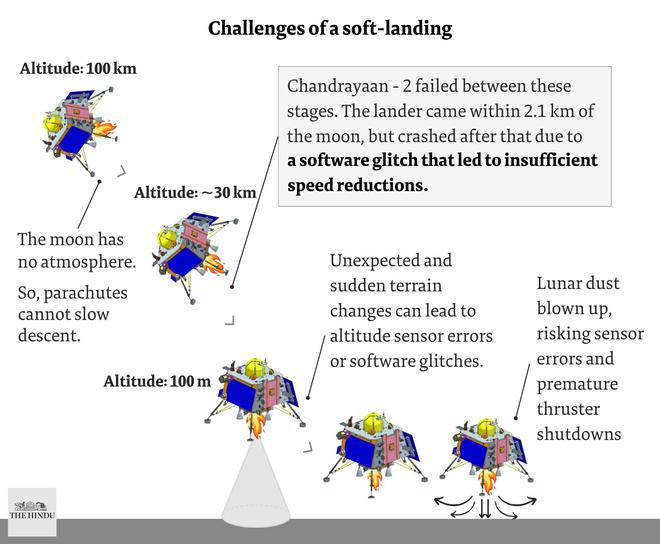
Even after speed reduction is achieved, there is the issue of lunar dust. When touching down, the lander’s thrusters blast lunar dust off the surface at high speeds. This can obscure the camera lens and trigger faulty readings.
Lunar dust
Lunar dust is the fine, abrasive particles of the moon’s surface. A lander soft-lands on the moon using its thrusters to control its descent speed. These thrusters let out a plume of exhaust, blowing the lunar dust around the lander. NASA’s video of the Apollo 15 lander’s touchdown shows how the thrusters set off a cloud of dust that completely obscures vision for a couple minutes until the landing ends.
Like Apollo 15, all other Apollo missions faced problems due to dust. Besides dust getting into the astronauts’ space suits and degrading suit pressure, it also caused devices to malfunction.
The Apollo 15 crew noted that landing radar outputs were affected at an altitude of about 30 ft by moving dust and debris. The dust coated the television camera lens and produced a halo in photographs. In the Apollo 12 mission, the landing velocity trackers gave false readings when they locked onto moving dust and debris during descent. All the Apollo landings were manually done to avoid wrong manoeuvres due to faulty readings. In the Apollo 16 mission, dust coated the lunar rover battery mirrors and overheated it.
In 1969, Apollo 12 landed near the Surveyor 3 landing device that had arrived on the moon two years earlier. Lunar dust from Apollo 12’s landing blasted Surveyor 3’s surfaces. Later, the Apollo 12 crew carried back some parts of Surveyor 3 for studying. NASA studied the extent of dust coating on the Surveyor.
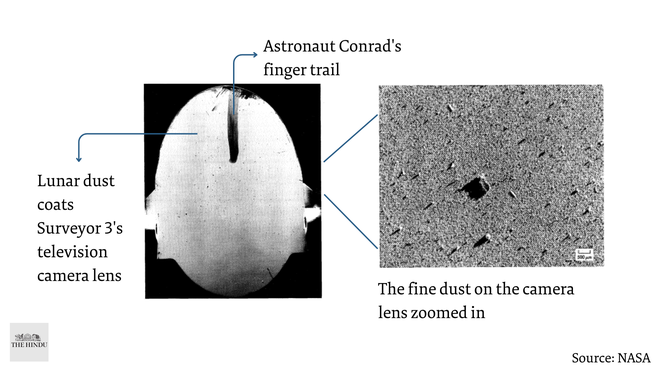
The extent of dust coating on landers may vary depending on factors like number of thrusters used during the final moments of landing, the landing site and touchdown velocity. However, the NASA report notes that “The presence of dust, even in very small quantities, can have a significant effect on temperature control and optical performance of hardware on the lunar surface.”
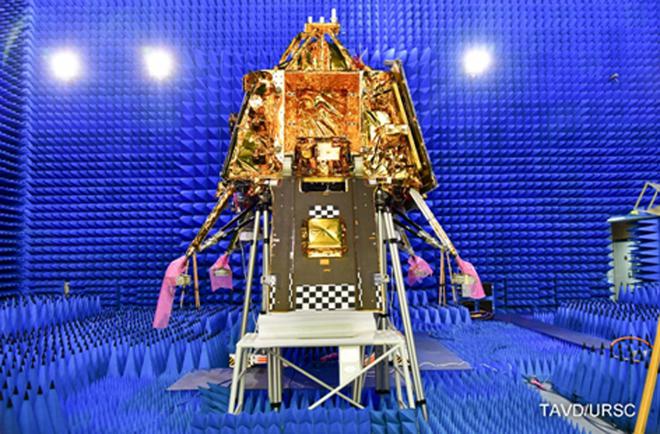
Chandrayaan-3’s lander thrusters have been improved after the glitches in Chandrayaan-2’s lander caused it to reduce speed insufficiently. While its predecessor had five thrusters, this mission’s lander has only four, making it easier to maintain equilibrium. Besides this, ISRO has made the lander’s legs sturdier, given it larger solar panels, increased fuel-carrying capacity and improved soft-landing sequences.
The agency has also tested equipment by soaking them in temperatures as cold as those in the moon and tested the lander’s legs by running landing simulations on surfaces similar to the lunar surface. The landing site chosen for Vikram in this mission is larger than that of the previous mission, measuring 4 kilometres by 2 kilometres. Landing velocity has been increased from 2 metres per second to 3 metres per second.
Vikram is set to land by August 23 or 24.
Chandrayaan-3 launch LIVE updates
Soft-landing success stories
Despite these challenges, three countries have managed to soft-land on the moon. For U.S.A., the success came after many failed attempts. It landed Surveyor 1 on the moon in 1966 during the height of the space race. China, on the other hand, landed Chang’e 3 successfully on its first attempt. Just a few months before Surveyor 1, the Soviet Union achieved the first successful soft-landing with Luna 9.
The graphic below shows where lunar missions have landed. Vikram will land on the South pole region, a region that has not been explored as much as the equatorial region.
The future for moon exploration already has a few important missions planned by major players. These are some of the recent and upcoming ones.







